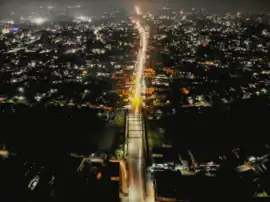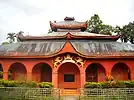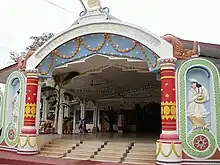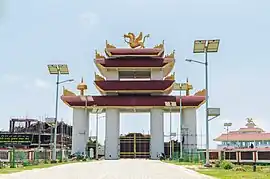Jorhat district
Jorhat (pron: ˈʤɔ:(r)ˌhɑ:t) is an administrative district of the Indian state of Assam situated in the central part of the Brahmaputra Valley. The district is bounded by Majuli on north, Nagaland state on the south, Charaideo on the east and Golaghat on the west. On the north of the district, the river Brahmaputra forms the largest riverine island of the world. The administrative seat is at Jorhat city.
Jorhat district | |
|---|---|
    From top, left-to-right: Jorhat aerial view, Lachit Bhawan at Lachit maidam, Dhekiakhowa Bornamghar, Sukapha Samannay Kshetra. | |
.svg.png.webp) Location in Assam | |
| Country | |
| State | Assam |
| Division | Upper Assam |
| Headquarters | Jorhat |
| Tehsils | 1. Jorhat East 2. Jorhat West 3. Titabor 4. Teok 5. Mariani |
| Government | |
| • Lok Sabha constituency | Jorhat |
| • Vidhan Sabha constituencies | Jorhat, Titabar, Titabar, Teok |
| Area | |
| • Total | 2,852 km2 (1,101 sq mi) |
| Population (2011)[1] | |
| • Total | 924,952 |
| • Density | 320/km2 (840/sq mi) |
| Demographics | |
| • Literacy | 83.42 % |
| • Sex ratio | 956 females per 1000 males |
| Time zone | UTC+05:30 (IST) |
| Vehicle registration | AS-03 |
| Major highways | NH-37 |
| Website | www |
Jorhat was previously a sub-division of undivided Sibsagar district. In 1983, Jorhat was carved out of Sibsagar District and was made a separate district.
Etymology
Jorhat (যোৰহাট) or Jorehaut means tween hats (Bazar) or mandis - Macharhat (মাছৰহাট) and Chowkihat (চকীহাট) which existed on the two different banks of the river Bhogdoi during the 18th century.
History
The northernmost area of the present district was a part of the Chutiya Kingdom before the Ahom-Chutiya war in the 16th century. In 1794 the Ahom king Gaurinath Singha shifted the capital from Sibsagar (erstwhile "Rangpur") to Jorhat. This town was a flourishing and commercial metropolis but completely destroyed after a series of the Burmese invasions since 1817 till the arrival of the British force in 1824 under the Stewardship of David Scott and Captain Richard.
The British rule, though, was not free from rebellions and revolutions, contributed to reemergence of this historical town. From the very first decade of the British rule, the great revolutionists who emerged were Gomdhar Konwar, Jeuram and Piyali, British system of administration, came into vogue in 1839 with an established Police Thana. During the great Sepoy Mutiny, the anti-British plot hatched by Maniram Dewan and Piyali Barua, was sabotaged. These leaders were hanged in public at this very place in 1858.[2]
In 1885, a narrow-gauge train service (Jorehaut Provincial Railway) came into operation and ultimately became instrumental in the rapid growth of the tea industry.
Though the civil sub-division under Sibsagar district at Jorhat was formed in 1869, this place was declared as administration headquarters of the undivided Sibsagar district in 1911, which comprised the present Sibsagar, Jorhat and Golaghat and parts of Karbi-Anglong district with Major A. Playfair as the first deputy commissioner.
The modern-day district of Jorhat was created in 1983 when it was split from Sibsagar district.[3]
Geography
On the north of the district, the river Brahmaputra forms the largest riverine island of the world, Majuli, spreading over 924.6 km2. with a population of about 1.50 lakh being threatened by the constant erosion by this mighty, unstable river. Majuli had been the principal place of pilgrimage of Vaishnavites since the ages of the Ahom rules. There are several Satras resembling medieval monasteries headed by Satradhikars preaching and teaching the Vaishnavism which was initiated by Sankardeva (1449–1568). Each Satra has unknown wealth of Vaishnav scriptures and extensive revenue free lands being cultivated by the "Bhakats" of the Satras.
Jorhat district occupies an area of 2,851 square kilometres (1,101 sq mi),[4] comparatively equivalent to Russia's Zemlya Georga.[5] Floods frequent the island every year without exception. The mean annual rainfall of the district is 2029 mm.
District administration
The District Administration is headed by Deputy Commissioner Ashok Kumar Barman, IAS.[6] is the Superintendent of Police of Jorhat district and belongs to the IPS batch of 2011 (Assam-Meghalaya cadre).[7]
The only outlying civil subdivision is Titabor . Titabor subdivisional administration is headed by SDO (Civil) Ayush Garg, IAS.
Divisions
There are five Assam Legislative Assembly constituencies in this district: Jorhat, Teok, Mariani, Titabor and Dergaon.[8] Dergaon is designated for scheduled castes.[8] Dergaon is in the Kaliabor Lok Sabha constituency. The other four are in the Jorhat Lok Sabha constituency.[9]
Economy
Agriculture
There are about 135 tea gardens, including out gardens, and the predominant field crop is rice, with per capita food grain production of 205 kg per annum.
Manufacturing industry
The district has a number of small-scale and cottage industries in the field of cane work and bamboo work, silver jewellery, furniture making, brass smithing, umbrella making, soap manufacturing, packaged food manufacturing etc. Type of industries present in Jorhat are agro based, cotton textile, woolen, silk & artificial thread based clothes, ready-made garments & embroidery, wood/wooden based furniture, chemical/chemical based, rubber, plastic & petro based, metal based (steel fab.), repairing & servicing, etc.
Tourism
Jorhat facilitates as the base location to reach out to many interesting places of international importance located at close proximity such as Majuli, Kaziranga National Park, Sivasagar, Gibbon Wildlife Sanctuary, the famous Molai forest, forested single handed, Dhekiakhowa Bornamghar, etc. Examples of numerous attractions that can be visited within the district are Lachit Borphukan's Maidam, Raja Maidam, Jorhat Science Centre & Planetarium, Jorhat Gymkhana Club, Chandrakanta Handique Bhavan, Jorhat District Museum, Thengal Manor, Sukapha Samannay Kshetra, Kaziranga Golf Resort, Shanti Ashram, Jagannath Temple, Thengal Cultural Centre & Museum, public parks, multiple tea gardens, Sukapha Park, Gabhoru Parbat and many more.
Demographics
According to the 2011 census Jorhat district has a population of 1,092,256,[1] roughly equal to the nation of Cyprus[10] or the US state of Rhode Island.[11] This gives it a ranking of 418th in India (out of a total of 640).[1] The district has a population density of 383 inhabitants per square kilometre (990/sq mi) .[1] Its population growth rate over the decade 2001-2011 was 9.21%.[1] Jorhat has a sex ratio of 956 females for every 1000 males,[1] and a literacy rate of 83.42%.
The divided district has a population of 924,952, of which 220,534 (23.84%) live in urban areas. Jorhat has a sex ratio of 963 females per 1000 males. Scheduled Castes and Scheduled Tribes are 64,787 (7.00%) and 62,368 (6.74%) of the population respectively.[1]
Main Assamese communities in the district are Tea tribes (Adivasi), Ahom, Chutia, Sonowal Kacharis, Thengal Kachari.
Religion
Hindus are 842,520 (91.09%) of the population. Muslims are 54,092 (5.85%) and Christians are 20,796 (2.25%) of the population.[12]
Languages
At the time of the 2011 census, 88.65% of the population spoke Assamese, 3.77% Bengali, 3.04% Hindi and 1.63% Mising as their first language.[13]
A tourist from other parts of India should not face and issue in communicating in Hindi. Likewise, for an international tourist communication in English is well understood.
Culture
The cultural diversities which prevailed in Jorhat nearly a century ago has inspired the people to participate in cultural activities through the decades and as a result Jorhat has been able to produce many creative writers, musician, actors, historians and journalists, terming Jorhat The Cultural Capital of Assam.
Festivals
Tea festivals
The Tea Festival is held in the district of Jorhat in the northeastern state of Assam in India. Jorhat is well known for its extensive tea gardens, and is the nerve centre of the tea industry. Jorhat has the world famous Tocklai Experimental Centre. In this place research work is carried out to find new varieties of tea and also the curative effects of green tea. The island of Majuli, the largest island on the Brahmaputra, and the Nambar Forest Reserve can be visited from Jorhat. In Majuli there are numerous monasteries and the Nambar Forest Reserve is famous for being a regenerating hot spring.
Description of Tea Festival
The Tea Festival in Jorhat is all about tea, music and gaiety. The Tea Festival in Jorhat brings about a world of festivity with a warm and traditional cordial reception. The Jorhat Tea Festival offers an excellent package of fun and excitement. The celebrations of the Festival of Tea in Jorhat include visit to the tea gardens, playing golf, safaris into the jungles, tasting delicious food items, shopping and cultural entertainment. The adventure sports on offer include angling and rafting in turbulent rivers. The Tea Festival of Jorhat in Assam is a pleasant blend of a business trip and a pleasure trip. Along with the beauty and cultural diversity of Assam, tourists can also meet the warm hearted people of Assam.
Time of Celebration of Tea Festival
The Tea Festival in Jorhat, in the state of Assam, is celebrated every year with great enjoyment, fun and entertainment
Majuli festivals
The northeastern state of Assam in India is famous for Majuli, the largest river island in the world, earlier a part of the district administration of Jorhat. The island of Majuli is positioned in the middle of river Brahmaputra and is the abode to the place of Vaishnavite culture in Majuli. The total area of Majuli has been diminishing gradually due to strong erosion of the river Brahmaputra. The Majuli Festival provides lot of opportunities to fit oneself into the festival. During the Majuli Festival in Assam, special events like cultural programs and exhibitions are organized.
Description of Majuli Festival
The Assam Majuli Festival is held on the bank of river Luit, the location of which has an immeasurably beautiful and picturesque milieu. The river Luit is just 1.5 kilometers from the sub-divisional headquarter of Majuli Island, Garamur. The Festival of Majuli in Majuli in Assam conducts many cultural programs with the cultural troupes of Majuli as well as troupes from the rest of the country. In the exhibition, Assamese products are on display, which are specially prepared and designed by artistes that draw attention to the traditional grandeur of Majuli. The organizers also arrange for a food festival in the Majuli Festival in Assam, where Assamese and tribal dishes are also made obtainable. Seminars are also organized to have a discussion on different topics. A display of various artwork and culturally driven masks can be seen in different museums located in the island.
Reaching the Majuli Festival of Majuli in Assam, one can observe the gathering and adjustment of all ethnic groups of people under the same sky, but at the same time the groups are keeping on their respective traditional and individual cultural entities. This is a very remarkable event. The island of Majuli has an environment of a bird sanctuary which attracts nonextant species of various migrant birds.
Time of Celebration of Majuli Festival
The Assam Majuli Festival is presumably held during the winter season, in the month of November. This arrangement is made keeping in mind the climate conditions and the road communicating facilities in Majuli.
Historical religious places
- Dhekiakhowa Bornamghar
- Burhi Gosani Devalaya
- Borbheti Than
- Garakhia Dol
- Moinaporia Namghar
- Buddha Vihar, Jorhat
Notable personalities
Jorhat has produced many creative writers, historians, journalists and many more.
- Birendra Kumar Bhattacharya, the first Assamese to win India's highest literature award, the Jnanpith Award[14]
- Jadav Payeng, the 'Forest man of India'
- Krishna Kanta Handique, ideologist and educationist, former vice chancellor of Gauhati University
- Hiren Bhattacharyya, Assamese poet
- Tarun Gogoi, former chief minister of Assam
- Zubeen Garg, musician
- Sonaram Chutia, Vaishnavite Scholar
- Munin Barkotoki, Writer
Flora and fauna
In 1997 Jorhat district became home to the Gibbon Wildlife Sanctuary, which has an area of 21 km2 (8.1 sq mi),[15] is a protected area which is home to hoolock gibbons.
There is another forest called Mulai Kathoni or Molai Forest, a man-made forest covering 550 hectares of area on a Brahmaputra river sandbar located near Kokilamukh area. It is named after Jadav Payeng, Indian environmental activist and forestry worker.
Molai forest and Payeng have been the subject of a number of documentaries. A locally made film documentary, produced by Jitu Kalita in 2012 The Molai Forest,[16] was screened at the Jawaharlal Nehru University. Jitu Kalita, who lives near Payeng's house, has also featured and given recognition on his reporting of the life of Payeng through his documentary. Molai forest was also featured in a 2013 documentary Foresting life,[17] directed by the Indian documentary filmmaker Aarti Shrivastava,[18] and in William Douglas McMaster's 2013 film documentary Forest Man.[19] People have pledged US$8,327 on the Kickstarter campaign[20] for the post-production of this documentary in early 2013, which was shown at 2014 Cannes Film Festival.[21][22]
About 100 km from Jorhat lies the internationally recognized Kaziranga National Park.
Education
Jorhat is considered one of the best locations for modern education in the state. The city of Jorhat has one of the highest number of educational institutions in the region. The literacy rate of the district of Jorhat is next to Kamrup Metropolitan.
The Jorhat Government Boys School is the oldest school established in 1883 with special facilities for science teaching. The Jagannath Barooah College is the premier and oldest college in the district (set up in 1930) and said to be first college in Upper Assam. Multiple schools and colleges had come up later. The people of Jorhat can rightly be proud of being a part of its glorious heritage and culture. Some notable schools in the district are Balya Niketon Kakojan, Balya Bhavan, Don Bosco High School, Baghchung, Army Public School Jorhat, Air Force School, Carmel Convent School, Hemalata Handiqui Memorial Institute, Don Bosco High School Lichubari, Jyoti Vidyapith Teok , Assam Rifle's Public School, Delhi Public School, Spring Dale High School, Maharishi Vidya Mandir, St. Mary's High School, Ben Garden High School, Kendriya Vidyalaya NEIST, Kendriya Vidyalaya ONGC, Kendriya Vidyalaya Air Force Station, Jawahar Navodaya Vidyalaya, Jorhat, Jonaki Sangha Vidyalaya, Assam Valley English Medium School, Sankar Dev Vidya Niketan, Bahona Boys High School, Royal Oak High School, Pragjyotika Titabar, Jatiya Vidyalaya Titabar, St. Anthony's High School, Maan International High School, Mihiram Saikia Higher Secondary School, Sankardev Seminary School, Jorhat Govt. Boys' H.S and M.P. School, Jorhat Govt. Girls H.S. and M.P. School, Jorhat Model Composite School, Gitarthi Girls High School, DCB Girls High School, Dipankar Vidyapith, 4 No Ward Primary School, Rashtrabhasa School, Rebakanta Baruah School, Bidyadhar Saikia School etc.
Jorhat is the seat of learning with the first agricultural university in the northeast region — Assam Agricultural University — established in 1969. Apart from that it has many prominent higher educational and research institutions. Those are - Jorhat Engineering College (1960), North East Institute of Science and Technology (NEIST) (1961), National Institute of Design, Jorhat (2019), Assam Women's University (2013), HRH The Prince of Wales Institute of Engineering and Technology (POWIET) (1926), Tocklai Tea Research Institute (1911), Rain Forest Research Institute (1988), Jorhat Medical College and Hospital (2009), Jorhat Institute of Science & Technology (JIST) and Kaziranga University (2012). Some other educational institutes of Jorhat districts are - CKB Commerce College, Jorhat College, Jorhat Law College, Dr.J.K.Saikia Homeopathic Medical College and Hospital, DCB Girls College, Bahona College, Jorhat Kendriya Mahavidyalaya, Kakojan College, Chandra Kamal Bezbaruah College, Nanda Nath Saikia College and Mariani College.
Media
The healthy education and cultural life of Jorhat can be best judged from the fact that the district has as many as five daily newspapers published from two publishing groups.
The Janambhumi Group of Publications are the oldest media group of Jorhat. The Saptahik Janambhumi, the Dainik Janambhumi, and the Eastern Clarion are its sister newspapers. The Spatahik Janambhumi celebrated its 50 years of circulation and the Dainik Janambhumi crossed its 25 years of existence.
The G.L. Publication publishes three newspapers from Guwahati and Jorhat simultaneously. They are the North East Times (English), Amar Asom (Assamese), and the Purbanchal Prohori (Hindi).
The other newspapers published from Jorhat are Dainik Agradoot, Asomiya Khabar and The Telegraph.
References
- "District Census Handbook: Jorhat" (PDF). censusindia.gov.in. Registrar General and Census Commissioner of India. 2011.
- Guptajit Pathak (2008). Assamese Women in Indian Independence Movement: With a Special Emphasis on Kanaklata Barua. Mittal Publications. p. 75. ISBN 978-81-8324-233-2. Retrieved 21 April 2012.
- Law, Gwillim (2011-09-25). "Districts of India". Statoids. Retrieved 2011-10-11.
- Srivastava, Dayawanti, ed. (2010). "States and Union Territories: Assam: Government". India 2010: A Reference Annual (54th ed.). New Delhi, India: Additional Director General, Publications Division, Ministry of Information and Broadcasting (India), Government of India. p. 1116. ISBN 978-81-230-1617-7.
- "Island Directory Tables: Islands by Land Area". United Nations Environment Program. 1998-02-18. Archived from the original on 2018-02-20. Retrieved 2011-10-11.
Zemlya Georga 2,821km2
- "New DC takes charge in Jorhat". Retrieved 2021-07-25.
- "Ankur Jain IPS posted as SP-Jorhat,Assam". Retrieved 2021-07-25.
- "List of Assembly Constituencies showing their Revenue & Election District wise break - up" (PDF). Chief Electoral Officer, Assam website. Archived from the original (PDF) on 22 March 2012. Retrieved 26 September 2011.
- "List of Assembly Constituencies showing their Parliamentary Constituencies wise break-up" (PDF). Chief Electoral Officer, Assam website. Archived from the original (PDF) on 22 March 2012. Retrieved 26 September 2011.
- US Directorate of Intelligence. "Country Comparison:Population". Archived from the original on June 13, 2007. Retrieved 2011-10-01.
Cyprus 1,120,489 July 2011 est.
- "2010 Resident Population Data". U. S. Census Bureau. Archived from the original on 2011-01-01. Retrieved 2011-09-30.
Rhode Island 1,052,567
- "Table C-01 Population By Religion: Assam". census.gov.in. Registrar General and Census Commissioner of India. 2011.
- "Table C-16 Population By Mother Tongue: Assam". censusindia.gov.in. Registrar General and Census Commissioner of India. 2011.
- "Bhattacharya, Birendrakumar" in Amaresh Datta, ed., Encyclopaedia of Indian literature vol. 1 (Sahitya Akademi, 1987), ISBN 978-81-260-1803-1, p. 482 (excerpt available at Google Books).
- Indian Ministry of Forests and Environment. "Protected areas: Assam". Archived from the original on August 23, 2011. Retrieved September 25, 2011.
- The Molai forest 2012 at IMDb
- "Foresting life". Humanity Watchdog. Archived from the original on 23 August 2013. Retrieved 1 April 2014.
- Foresting life 2013 at IMDb
- Forest Man 2013 at IMDb
- "Forest Man post production". Kickstarter. 14 February 2013. Retrieved 29 April 2014.
- "Payeng film gets Cannes award". The Telegraph, Calcutta, India. 26 May 2014. Archived from the original on July 25, 2014. Retrieved 17 July 2014.
- "The American Pavilion 2014 Finalists Emerging Filmmaker Showcase". The American Pavilion. Retrieved 17 July 2014.